Something we take for granted about the crescent Moon’s appearance may be nothing more than an optical illusion.
Public domain
Have you ever looked at a crescent Moon and noticed that the rim of the earthlit portion looks brighter?
Observers have been aware of the phenomenon for centuries. Before we knew the Moon's true nature as an opaque, rocky body like the Earth, some astronomers in Galileo's time even thought the Moon could be translucent. Sunlight streaming from behind the Moon along our line of sight would pass more easily through the limb — where less material would block the light — than the center, making the edge appear brighter.
While we know this isn't how earthshine works, the perception of a glowing lunar ring has persisted to the present day. I've seen it, as have my observing buddies. Edge-brightening even shows up in paintings like the one featured here, begging the question: is it a real phenomenon or due to human perception? As it turns out, it may be a bit of both!
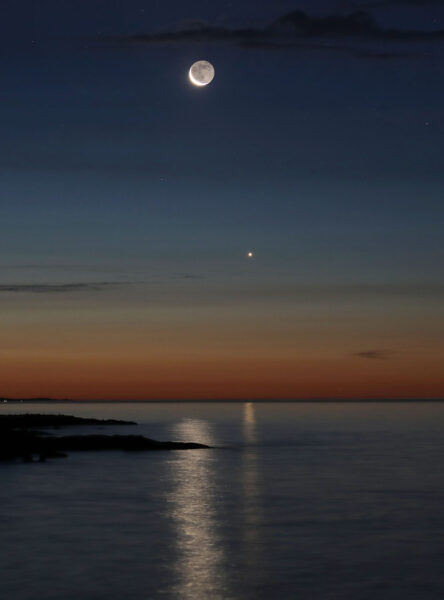
Bob King
Every lunation we're treated to back-to-back crescents separated by the new Moon. While much is made of the Full Moon and its rising (understandably so), give me a crescent anytime. Few objects in the celestial sphere are more pleasing to behold than the petal-like Moon at dusk or dawn. Pointy as a knife tip yet seductively curved, the crescent's disparate qualities dovetail to make it an irresistible sight. Earthshine — sunlight reflected from Earth to the Moon and back — makes it even more compelling, especially during the 2-to-3 day period before and after a new Moon.
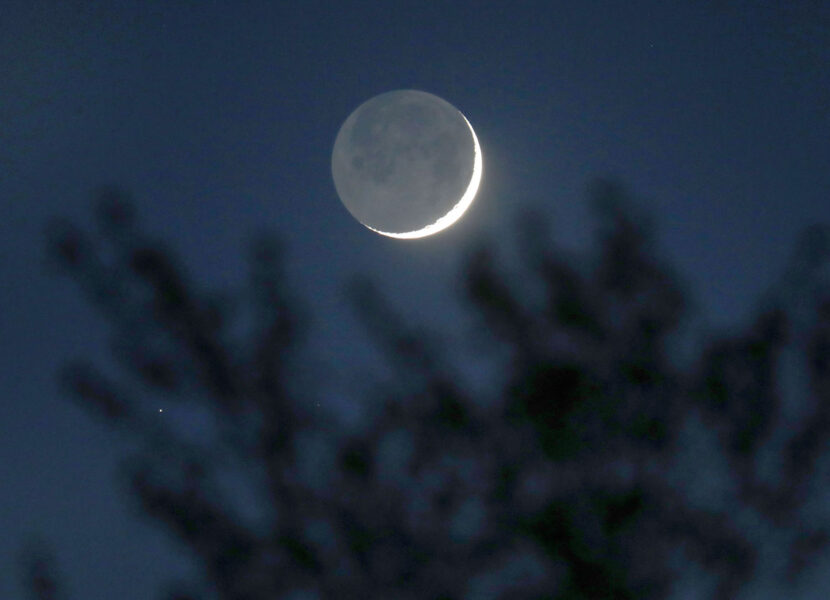
Bob King
Moon and Earth phases are complementary. When we see a crescent, a lunar astronaut gazes at a nearly full Earth. For that reason, earthshine is brightest during the Moon's crescent phase and decreases as the Moon fills out. The increasing glare of the waxing sunlit portion also hampers earthshine's visibility toward the middle of the cycle.
I might not have looked any further into the matter were it not for a call to action from Christopher Graney, public relations officer for the Vatican Observatory Foundation, and an adjunct scholar at the Vatican Observatory. He specializes in the history of late 16th- and early 17th-century astronomy and writes for the biweekly Observatory Newsletter. He asked for help, including photographs, that might pin down the origin of the phenomenon.
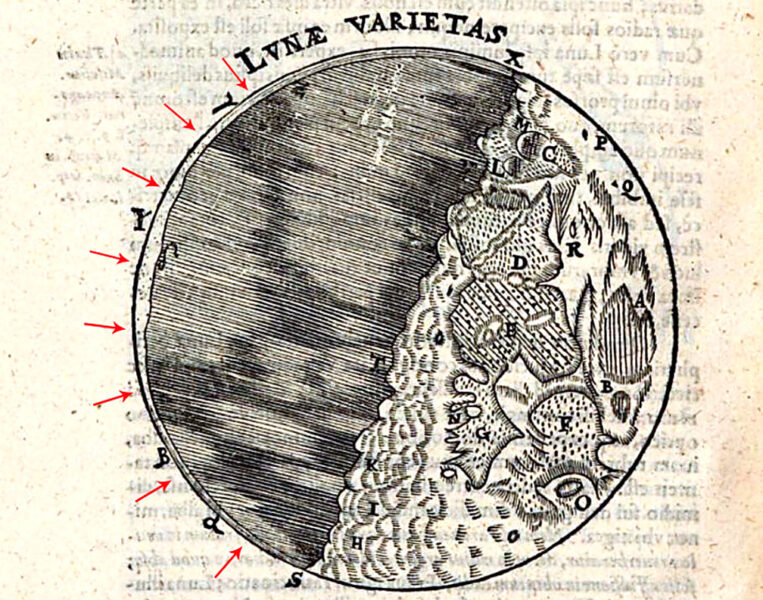
In a recent column, Graney discussed past and present observations of the limb glow, especially those made by early 17th-century astronomers Johann Georg Locher, his mentor Christoph Scheiner, and Galileo. Scheiner and Locher were convinced that sunlight passing through the Moon caused the "secondary light," the name given earthshine in their time.
Galileo, on the other hand, correctly attributed the cause to earth-light in his 1632 book Dialog Concerning Two Chief World Systems. In fact, he was so incensed by Locher's hypothesis that he called it “a lie that borders upon rashness."
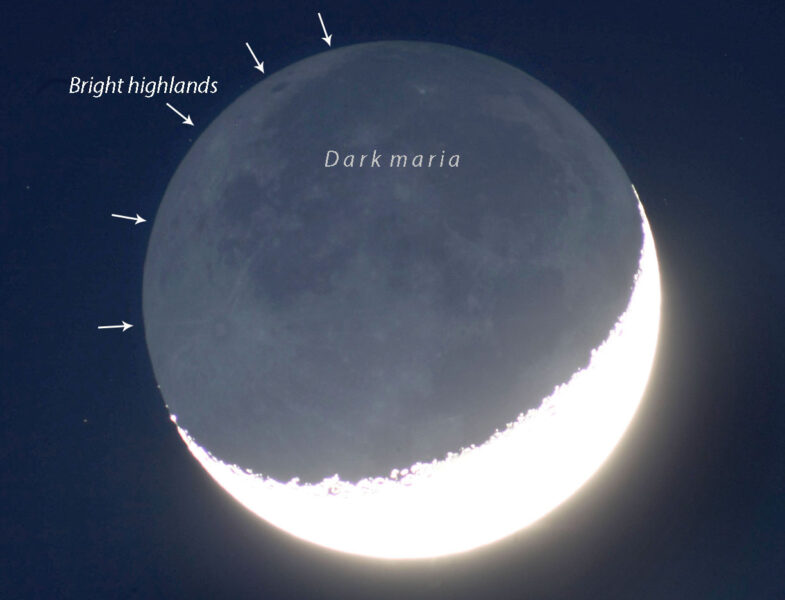
Bob King
Intrigued, I spent time this past June observing and photographing crescent Moons at dusk and dawn. I confirmed the brighter limb effect with my eyes, but since it never appeared in any of my images, I had to conclude that human perception was the cause.
But there's a caveat: If you look closely at the evening crescent you'll see that bright highlands rim the limb, while the vast expanse of the dark Ocean of Storms and other maria lie interior to it. Highland materials reflect about twice as much light as the maria, making it possible that lunar geography plays at least a small role in enhancing earthshine along the limb.
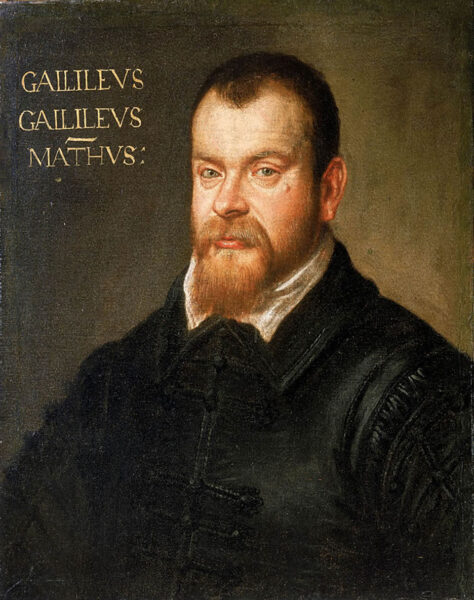
Public domain
I could see the effect of the lighter-toned highlands even better when I blocked out the sunlit crescent and used averted vision. But it seemed too subtle to account for all of the edge effect, so I took a closer look at Galileo's explanation of the secondary light in his Dialog. He writes:
"It is true that the Moon shows such a circle when observed in twilight at its first appearance after New Moon, but that originates deceptively in differences between the boundaries which terminate the lunar disk over which this secondary light is spread. For on the side toward the Sun, the light is bounded by the bright horn of the moon; on the other side, it has for its boundary the dark field of the twilight, in relation to which it appears lighter than the whiteness of the lunar disk— which on the other side is obscured by the greater brilliance of the horns. If only this modern author (referring to Locher) had tried placing between his eye and the primary brilliance some screen such as the roof of a house, or some other partition, so that only the part of the Moon outside the horn remained visible, he would have seen it all equally luminous."
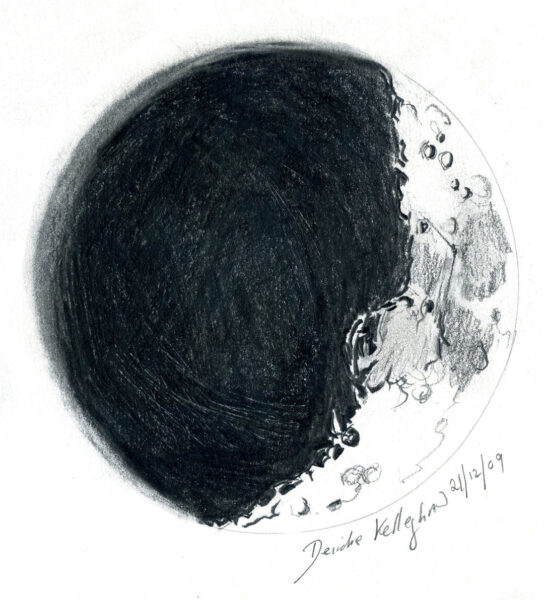
Deirdre Kelleghan
In other words, it's about how the human eye perceives different tones that are adjacent to one other. Next to the bright glare of the crescent, the earthshine appears darker. When earthshine butts up against the darker sky it appears brighter. This is also also known as the Mach band effect, named for Austrian physicist Ernst Mach who first reported the illusion in 1865.

Bob King
Mach discovered that if you take two gray rectangles of slightly different shades and place them side by side, the difference in their tones makes our brains see a lighter band (Mach band) where they touch. I'd offer that this is identical to the situation with earthshine, where gray earthlight shares a border with black (or dark gray) sky, rendering the contact zone a shade brighter.
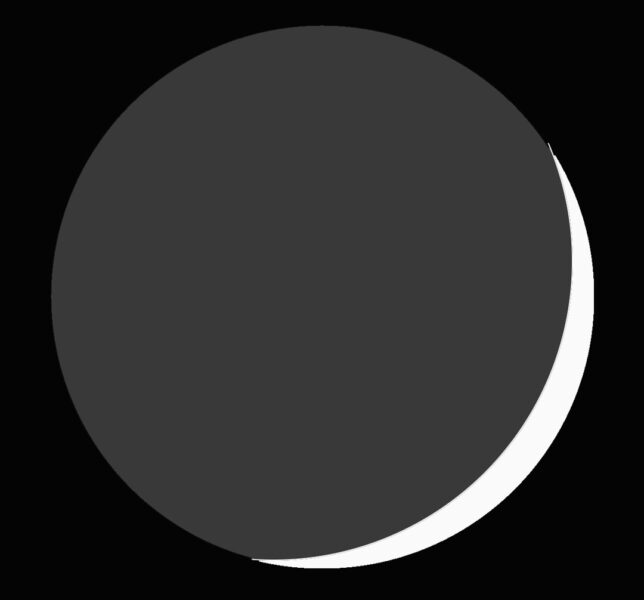
Bob King
Edge detection helps us see where one object ends and another begins. Animals use it to help them distinguish well-camouflaged prey against a busy backdrop. Birds are known to use contrasting edges to target a safe and secure landing. Anything that makes borders easier to see is a useful skill.
While no expert, I think the same ability plays a key role — along with a dash of lunar geography — in our perception of the bright, earthlit ring shown so convincingly in the painting. I want to thank Chris for the inspiration to look more closely and would love to hear about your own observations of the phenomenon. The next opportunity to view the waxing, earthlit crescent occurs between July 30th and August 3rd.
 21
21









Comments
Martian-Bachelor
July 27, 2022 at 2:04 pm
> Have you ever looked at a crescent Moon and noticed
> that the rim of the Earth-lit portion looks brighter?
Honestly, no, First I've ever heard of this.
Expectations also play a role in what one thinks one sees.
I do wonder if the Mach effect has been tested at low (scotopic) light levels, or only at photopic ones.
You must be logged in to post a comment.
Anthony-Mallama
July 27, 2022 at 2:06 pm
Bob,
This topic is intriguing and your explanation is compelling. The only question I have is why the brighter limb effect never appeared in any of your photographs. It does show in the last illustration which is similar to a photo.
Tony Mallama
You must be logged in to post a comment.
Bob KingPost Author
July 27, 2022 at 4:18 pm
Hi Tony,
Indeed it does show in the sketch, but that was done through a telescope and may simply record a general impression of the lunar highlands along the limb. Good question about the photographic appearance. My first thought is that the camera only records things, so it can't be deceived by perception. But I also suspect it may have to do with the level of detail visible in a photo. We're no longer looking at simple tonal values. We can't see those details with the unaided eye when viewing the moon, so it's simplifies down to contrasting grays, ie. Mach bands.
You must be logged in to post a comment.
Stephen-Carroll
July 27, 2022 at 4:40 pm
Hi Bob,
Thank you for introducing me to the Friedrich painting. I think it's beautifully mesmerizing...
You must be logged in to post a comment.
Bob KingPost Author
July 27, 2022 at 4:46 pm
Stephen,
I agree. I love how it captures the Moon as part of nature and our fascination with it. There's a certain mood about it as well.
You must be logged in to post a comment.
Anthony Barreiro
July 27, 2022 at 8:47 pm
That is a beautiful picture of the Moon and Venus over Lake Superior!
Contrast effects are powerfully convincing. Sunspots are blindingly bright. But seen through a solar filter surrounded by the even brighter surface of the sun, a sunspot looks dark.
Edge-sharpening is built into our entire visual perceptual system, at every level from the reciprocal inhibition of adjacent rod cells and cone cells in our retinas up to how signals are interpreted in the visual cortex of the brain.
You must be logged in to post a comment.
Bob KingPost Author
July 28, 2022 at 10:17 am
Hi Anthony,
Thank you. Before writing this I never appreciated the importance of edges. I have a different perspective now.
You must be logged in to post a comment.
Frank-ReedNavigation.com
July 28, 2022 at 1:14 pm
I wonder what earthshine looks like in lunar orbit? When we see the Moon from here on Earth, we're looking straight down from nearly the same direction as the source of illumination. That makes the earthshine uniform and featureless, apart from the albedo effects of maria versus highlands, etc. There are no "earthshine shadows". But imagine orbiting the Moon at First Quarter. You swing around from the far side, and pass over Mare Orientale. It's smack in the middle of the dark half at low southern latitude, but it's on the dividing line between the side lit only by starlight and the side illuminated by earthlight. The mountains around the basin would cast long shadows... in earthshine.
You must be logged in to post a comment.
Bob KingPost Author
July 29, 2022 at 10:22 am
Hi Frank,
Thanks for your comment and perspective. About moon phases and M. Orientale. Remember that because Earth-moon phases are complementary, when we see a first quarter moon, the lunar farside experiences a last quarter moon. So when you came around to the backside you'd see half the moon illuminated by sunlight and half by weak earthshine.
You must be logged in to post a comment.
Frank-ReedNavigation.com
July 29, 2022 at 11:08 pm
Bob, As you come around in lunar orbit, you would pass over the "earthlight terminator", which is what I was trying to describe. Of course an entire side of the Moon is also illuminated directly by the Sun, but you wouldn't see any of that for another, maybe, 20 minutes as you're looping around (assuming a low lunar orbit -- and all stable lunar orbits are low orbits). What would you see then? Looking down at the landscape illuminated by the soft glow of earthlight, you would see long shadows, just like at the "sunlight terminator" but much fainter. See, here's the thing: down here on Earth we have a unique and unusual perspective on earthshine. We always see it with the appearance of a proper Full Moon: no shadows, uniform brightness all the way across the lunar surface, and only albedo differences visible. The earthlit portion of the Moon looks exactly like the same portion of the Full Moon with the brightness turned way down.
You must be logged in to post a comment.
Bob KingPost Author
July 30, 2022 at 12:46 am
Hi Frank,
I misunderstood you the first time and pictured M. Orientale at the bright terminator. Yes, that's true and a lovely thought! I suspect that shadows by earthlight would be primarily visible from locations on the moon where the Earth is near the horizon, just as the low sun casts striking shadows along the nearside terminator. M. Orientale (M. Marginis, etc.) would be perfect locations to try and see these shadows from orbit. Although on the faint side, I agree, they should be there! Which now makes me wonder if the astronauts were looking and noticed . . . ?
You must be logged in to post a comment.
Anthony Barreiro
July 30, 2022 at 6:14 pm
That is a lovely thought. Took me a minute to mentally picture it.
The Earth is 16 times bigger in the Moon's sky than the Moon is in Earth's sky, so the penumbra of an Earth shadow on the Moon would be much wider than the penumbra of a Moon shadow on the Earth. But on the other hand, here on Earth, Moon shadows are diffused by the atmosphere. I wonder how Earth shadows would appear on the airless surface of the Moon?
The Apollo missions always happened during waxing Moon phases, so the command module would have orbited over the "Earthlight terminator." Like Bob, I wonder, did the astronauts take any pictures?
We'll have to wait for somebody to explore the Earthlit side of the Moon and start singing, "I'm being followed by an Earth shadow, Earth shadow ... ." With apologies to Cat Stevens.
You must be logged in to post a comment.
Psalm19Astronomy
July 28, 2022 at 4:07 pm
Interesting article on earthshine! I figured there might be a brain processing component to the DaVinci glow that we see much as the optical illusion of the Moon appearing much larger when it is on the horizon.
Leonardo da Vinci was the first to propose that the ghostly glow of the dark side of the Moon during crescent phases was due to sunlight bouncing off of Earth's oceans onto the dark side of the Moon. He proposed this back in 1510 - a hundred years before Hans Lippershey invented the spyglass i.e., telescope!
You must be logged in to post a comment.
Psalm19Astronomy
July 28, 2022 at 4:09 pm
Here's the link to the NASA article on the DaVinci glow.
https://science.nasa.gov/science-news/science-at-nasa/2005/04oct_leonardo/
You must be logged in to post a comment.
Bob KingPost Author
July 29, 2022 at 10:17 am
Thanks P19A,
Leonardo was one smart dude! Thanks for the link.
You must be logged in to post a comment.
Kevan Hubbard
July 29, 2022 at 5:22 pm
Beautiful picture of the Moon and Venus and I took a similar one but with no water features in the north Pennine Mountains in northern England at an ungodly 0400hr on the 27th but no earthshine as it was already too light.Actually, with hindsight,I could kick myself as I saw Saturn, Jupiter, Mars and Venus that night but I didn't realize that Uranus was just behind Mars and I could have spotted it too just leaving Mercury and Neptune missing (look at my feet and I have the Earth!).I was traveling light with just my tiny Zeiss Mini Quick monocular at 5x10 on me but I can get Uranus in it no problem although Neptune I don't think so but I haven't tried .
You must be logged in to post a comment.
Bob KingPost Author
July 30, 2022 at 12:50 am
Hi Kevan,
Thank you! Nice to know you got up to see them, too. Sorry, you missed the earthshine. You probably know this already, but Mars passes just 1.4° from Uranus on August 1 UT.
You must be logged in to post a comment.
JohnofYork
July 29, 2022 at 5:37 pm
I don't suppose that light reflects off mountain peaks on the (hidden from us) illuminated side of the Moon and then off the next peak and so on until a very small percentage reaches the limb that we can see. Could that be it?
You must be logged in to post a comment.
Bob KingPost Author
July 30, 2022 at 12:35 am
Hi John,
Good thought! I considered that but abandoned it because if true, we should be able to capture any such reflected light in photos, and we don't. Also, the earthshine continues to show clearly several days after new moon, making the light on the illuminated farside even farther removed from the lunar nearside. That would be a LONG way to bounce! If light bouncing off mountains were a factor we'd more likely see it on the nearside, say around first quarter moon, when light from the mountains would brighten the strip of land immediately adjacent to the terminator. I've not heard of anyone seeing this though perhaps there would be a way to record it. Glare from the illuminated moon would certainly make it tricky!
You must be logged in to post a comment.
ToomasKarmo
August 23, 2022 at 8:14 am
The remark on the caption accompanying Tintoretto's Galileo portrait currently reads, "'Mathus' in the inscription refers to [Galileo's] position as master of mathematics at the University of Padua." This might in the interests of fully correct and fully explicit Latinity be amended to "'Mathus' in the inscription is an elision (as marked by the horizontal stroke above the lettering) of 'Mathematicus', in reference to [Galileo's] position as master of mathematics at the University of Padua."
You must be logged in to post a comment.
Bob KingPost Author
August 23, 2022 at 5:09 pm
Thank you for your email, Toomas and the precision of your scholarship. I kept it simple so as not to go too deep into the weeds on that particular detail.
You must be logged in to post a comment.
You must be logged in to post a comment.